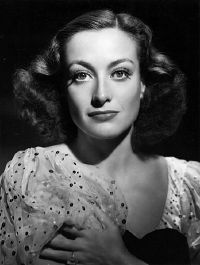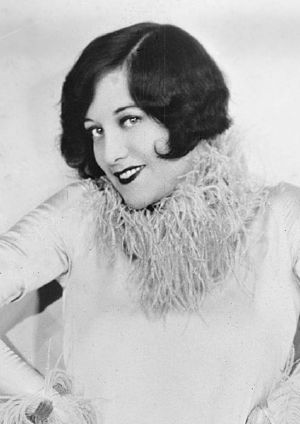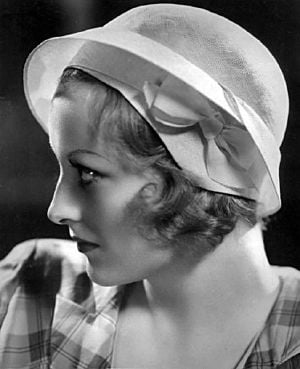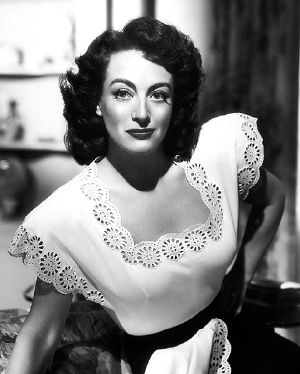Joan Crawford
| Joan Crawford | |
 Joan Crawford | |
| Birth name: | Lucille Fay LeSueur |
|---|---|
| Date of birth: | March 23, 1904[1] |
| Birth location: | San Antonio, Texas, USA |
| Date of death: | May 10, 1977 |
| Death location: | New York City, New York, USA |
| Spouse: | Douglas Fairbanks, Jr Franchot Tone Phillip Terry Alfred N. Steele |
Joan Crawford (March 23, 1904[1] - May 10, 1977) was an acclaimed, iconic, Academy Award winning American actress, arguably one of the greatest from Hollywood's golden years of the 1920s, 30s, and 40s. The American Film Institute named Crawford among the Greatest Female Stars of All Time, ranking at No. 10. She enjoyed one of the most successful and longest-lived careers in cinema history.
Early life
Joan Crawford was born Lucille Fay LeSueur in San Antonio, Texas, the third child of Tennessee-born Thomas E. LeSueur and Anna Bell Johnson. She had one sister, Daisy, and a brother, Hal.[2] Although Crawford was of mostly English descent, her surname originates from her great-great-great-great grandparents who immigrated from London, England in the early 1700s to Virginia, where they lived for generations.
Crawford's father abandoned the family in Texas. Her mother later married Henry J. Cassin. The family lived in Lawton, Oklahoma, where Cassin ran a movie theater. Crawford's ambition was to be a dancer. Unfortunately, she cut her foot deeply on a broken milk bottle when she leaped from the front porch of her home. She was unable to attend elementary school for a year and a half and eventually had three operations on her foot. Demonstrating the steely determination that would serve her for the rest of her life, she overcame the injury and returned not only to walking normally, but to dancing as well.
She loved watching vaudeville acts perform on the stage of her stepfather's theater. At that time, Crawford was reportedly unaware that Cassin, whom she called "Daddy," was not her biological father; her brother later told her the truth.[3] In June 1917, the family moved to Kansas City, Missouri, after Cassin was accused of embezzlement; although acquitted, he was blacklisted in Lawton.[4]
Cassin allegedly began sexually abusing her when she was eleven, and continued until she was sent to St. Agnes Academy, a Catholic girls' school in Kansas City.[2] Later, after her mother's marriage to her stepfather ended, she stayed on at St. Agnes as a work student. Following her time at St. Agnes, she went to Rockingham Academy, continuing as a work student.
Early Career
She began as a dancer in a chorus line under the name Lucille LeSueur, eventually making her way to New York City. In 1924, she went west to Hollywood and signed a contract with Metro Goldwyn Mayer, and arrived in Culver City, California, in January, 1925.
Crawford began acting in silent films. She worked hard to ensure that her contract with the studio would be renewed. Studio chief Louis B. Mayer was unhappy with her name. A contest in the fan magazine, Movie Weekly, became the source of her well-known stage name. The female contestant who entered the name Joan Crawford was awarded five hundred dollars. Though Crawford called herself Jo-Anne for some time, and reportedly detested the name Crawford at first because it sounded like "crawfish," she admitted she "liked the security" of the name.[3] She eventually accepted the studio's preference and adopted the name Joan Crawford permanently.
Crawford first made an impression on audiences in Sally, Irene and Mary (1925), in which she played Irene, a struggling chorus girl who meets a tragic end. The following year, she was named one of the WAMPAS Baby Stars, which honored thirteen young women each year who the studios believed to be on the threshold of movie stardom. For the next two years she appeared in increasingly important movies as the romantic interest for some of MGM's leading male stars, among them Ramon Novarro, William Haines, John Gilbert, and Tim McCoy.
Crawford's role as Diana Medford in Our Dancing Daughters (1928) catapulted her to stardom and established her as a symbol of modern 1920s-style femininity that rivaled the image of Clara Bow, who was then Hollywood's foremost movie actress. A stream of hits followed Our Dancing Daughters, including two more flapper-themed movies, in which Crawford embodied for her legion of fans, mostly female, an idealized vision of the free-spirited, all-American girl.
Crawford studied diction and elocution tirelessly to rid herself of her distinct Texan, Oklahoman accent. Her first talkie was Untamed (1929) opposite Robert Montgomery, a box-office success. The movie proved to be an important milestone for the durable star, as she made an effective transition to sound movies. One critic observed, "Miss Crawford sings appealingly and dances thrillingly as usual; her voice is alluring and her dramatic efforts in the difficult role she portrays are at all times convincing."
Hollywood
During the early 1930s, Crawford modified her image to better fit the hard-scrabble conditions of Depression-era America. In this new role, she played a glamorized version of the working girl who relied on her intelligence, looks, and sheer determination to get ahead in life. On the strength of this new star persona she became known as the "Queen of the MGM Lot." One indication of her lofty status was the studio's decision to cast Crawford in its most important movie of 1932, the all-star extravaganza Grand Hotel.
During this time, she achieved special success in a series of steamy pairings opposite Clark Gable, in which they established themselves as the most formidable romantic duo of the 1930s. Their rollicking smash hit Dancing Lady (1933), in which Crawford received top billing over Gable, was the only movie to feature the talents of Robert Benchley, Nelson Eddy, Fred Astaire and the Three Stooges all together in one movie. Her next two movies also paired her with Gable, and were very well received, being among the top money makers of the mid-1930s, and marked Crawford's peak at Metro Goldwyn Mayer as a popular star at the box-office.
Eager to promote their new generation of female stars, among them Greer Garson, Lana Turner, Judy Garland, Hedy Lamarr, and the resurgent Katharine Hepburn, the management at MGM began to view Crawford as a bad investment. After eighteen years at the studio, Crawford's contract was terminated by mutual consent on June 29, 1943. In lieu of one more movie owed under her contract, she paid the studio one hundred thousand dollars. That same day, she drove herself to the studio and cleaned out her dressing room.
Upon leaving MGM, Crawford signed with Warner Bros. for half a million dollars for three movies and was placed on the payroll July 1, 1943, the next day after leaving MGM. She appeared as herself in the star-studded production Hollywood Canteen (1944) and was cast in the title role in Mildred Pierce (1945). Director Michael Curtiz and producer Jerry Wald developed the property specifically for Crawford from the popular James M. Cain novel, which was adapted for the screen by Ranald MacDougall. The final product was a commercial and artistic triumph. Mildred Pierce served as a first-rate vehicle for Crawford, highlighting her skills as an actress and allowing her to inhabit a new persona as the tortured heroine of glossy melodrama. Joan Crawford received the Academy Award for Best Actress in a Leading Role for her performance.
For the next several years, Crawford reigned as a top star and respected actress, appearing in such memorable roles as Helen Wright in Humoresque (1946), as Louise Howell Graham in Possessed (1947) opposite Van Heflin and Raymond Massey, for which she was nominated for a second Oscar as Best Actress. Aside from acting in motion pictures, Crawford also worked in radio and television. She appeared a number of times in episodes of anthology TV shows in the 1950s and, in 1959, made a pilot for her own series, The Joan Crawford Show, but it was not picked up by a network.
By the early 1960s Crawford's status in motion pictures had diminished significantly. She managed to reverse this trend one last time when she accepted the role of Blanche Hudson in the low-budget, but highly successful, What Ever Happened to Baby Jane? (1962), opposite Bette Davis, directed by Robert Aldrich.
Other work
Besides her work as an actress, from 1955 to 1973, Crawford traveled extensively on behalf of husband Alfred Steele's company, PepsiCo. Two days after Steele's death in 1959, she was elected to fill his vacancy on the board of directors. Crawford was the recipient of the Sixth Annual "Pally Award," which was in the shape of a bronze Pepsi bottle. It was awarded to the employee making the most significant contribution to company sales. In 1973, she retired from the company at the behest of company executive Don Kendall, whom Crawford had referred to for years as "Fang."
Her last public appearance was a party honoring Rosalind Russell at New York's Rainbow Room in 1974.
Personal Life
Crawford had four husbands: actors Douglas Fairbanks, Jr., Franchot Tone, Phillip Terry, and Pepsi-Cola president Alfred N. Steele. Each of her marriages lasted four years and all ended in divorce except her final marriage, which survived until the Steele's death in 1959.
Crawford adopted six children, according to L.A. Times articles from the time, though she kept and raised only four. The first was Christina, whom Crawford adopted in 1940 while a single, divorced woman. The second was a boy she named Christopher. In 1942, his biological mother found out where he was and managed to get the adoption reversed. The third child was an 8-year-old that Crawford named Phillip Terry, Jr. She and then husband, Phillip Terry, adopted the child in April 1943, but did not keep him. The fourth child was Christopher Terry. Crawford and Terry adopted him later that year, and he remained her son, renamed as Christopher Crawford, after she and Terry divorced. The fifth and sixth children were twin girls Cynthia "Cindy" Crawford and Cathy Crawford.
Crawford was raised as a Roman Catholic; her stepfather, Henry Cassin, although Catholic, ultimately divorced his wife Anna. Crawford insisted on marrying her first husband, Douglas Fairbanks, Jr., in a Roman Catholic church.
She later converted and became a Christian Scientist.
Crawford published her autobiography, A Portrait of Joan, co-written with Jane Kesner Ardmore, in 1962 through Doubleday.[5] Crawford's next book, My Way of Life, was published in 1971 by Simon & Schuster.[6] Those expecting a racy tell-all were disappointed, although Crawford's meticulous ways were revealed in her advice on grooming, wardrobe, exercise, and even food storage.
On May 8, 1977, Crawford gave away her Shih Tzu as she was no longer able to care for her. Joan Crawford died two days later at her New York City apartment of a heart attack. She was also suffering from pancreatic cancer. A funeral was held at Campbell Funeral Home, New York. All four of her adopted children attended, as well as her niece, Joan Crawford LeSueur, the daughter of her late brother, Hal LeSueur. Hal LeSueur had died in 1963. She was cremated and her ashes placed in a crypt with her last husband, Alfred Steele, in Ferncliff Cemetery, Hartsdale, New York.
Crawford's Last Will and Testament was read to the family that evening.
In the will, which was signed October 28, 1976, she bequeathed to her two youngest children, Cindy and Cathy, $77,500 each from her $2,000,000 estate. However, she explicitly disinherited the two eldest, Christina and Christopher. In the last paragraph of the will, she wrote, "It is my intention to make no provision herein for my son Christopher or my daughter Christina for reasons which are well known to them."
Legacy
A memorial service was held for Crawford at All Souls' Unitarian Church on Lexington Avenue in New York on May 16, 1977, and was attended by, among others, her old Hollywood friend Myrna Loy. Another memorial service, organized by George Cukor, was held on June 24, 1977, in the Samuel Goldwyn Theater at the Academy of Motion Picture Arts and Sciences in Beverly Hills, California.
Shortly after her death, the eldest of her four children, Christina, published an exposé that became a bestseller, containing allegations that Crawford was emotionally and physically abusive to her and her brother, Christopher.[7] Though many of Crawford's friends (as well as her other daughters, Cynthia and Cathy) harshly criticized and disputed the book's claims, other friends did not, and her reputation was severely tarnished. The book was later made into a movie of the same title, Mommie Dearest, starring Faye Dunaway.
Crawford's hand and foot prints are immortalized in the forecourt of Grauman's Chinese Theater on Hollywood Boulevard in Hollywood, and she has a star on the Hollywood Walk of Fame at 1750 Vine Street for her contributions to the motion picture industry. In 1999, Crawford was also voted the tenth greatest female star of the classic American cinema by the American Film Institute.[8]
Joan Crawford's true legacy as an actress are the more than 100 films in which she appeared.
Notes
- ↑ 1.0 1.1 Crawford's year of birth is uncertain, as various sources claim 1904, 1905, 1906, and 1908. Crawford herself widely claimed 1908 (the date on her tombstone). Crawford's daughter Christina states "1904" twice in Mommie Dearest.
- ↑ 2.0 2.1 Lawrence J. Quirk and William Schoell, Joan Crawford: The Essential Biography (Lexington: University Press of Kentucky, 2002, ISBN 0813122546).
- ↑ 3.0 3.1 Roy Newquist, Conversations With Joan Crawford (Citadel Press, 1980, ISBN 978-0806507200).
- ↑ Donald Spoto, Possessed: The Life of Joan Crawford (William Morrow, 2010, ISBN 978-0061856006).
- ↑ Joan Crawford and Jane Kesner Ardmore, A Portrait of Joan (Graymalkin Media, LLC, 2017, ISBN 978-1631681134)
- ↑ Joan Crawford, My Way of Life (Simon & Schuster, 1971, ISBN 978-0671209704).
- ↑ Christina Crawford, Mommie Dearest (William Morrow & Co, 1978, ISBN 978-0688033866).
- ↑ Susan Ware and Stacy Braukman (eds.), Notable American Women: A Biographical Dictionary, Volume 5: Completing the Twentieth Century (Belknap Press, 2005, ISBN 978-0674014886).
ReferencesISBN links support NWE through referral fees
- Bret, David. Joan Crawford: Hollywood Martyr. NY: Carroll & Graf, 2006. ISBN 0786718684
- Crawford, Christina. Mommie Dearest. William Morrow & Co, 1978. ISBN 978-0688033866
- Crawford, Joan. My Way of Life. Simon & Schuster, 1971. ISBN 978-0671209704
- Crawford, Joan, and Jane Kesner Ardmore. A Portrait of Joan. Graymalkin Media, LLC, 2017 (original 1962). ISBN 978-1631681134
- Newquist, Roy. Conversations With Joan Crawford. Citadel Press, 1980. ISBN 978-0806507200
- Quirk, Lawrence J., and William Schoell. Joan Crawford: The Essential Biography. Lexington: University Press of Kentucky, 2002. ISBN 0813122546
- Spoto, Donald. Possessed: The Life of Joan Crawford. William Morrow, 2010. ISBN 978-0061856006
- Thomas, Bon. Joan Crawford: A biography. NY: Bantam Books, 1970. ISBN 0553129422
- Vogel, Michael. Joan Crawford: Her Life in Letters. Shelbyville, KY: Wasteland Press, 2005. ISBN 1933265469
- Ware, Susan, and Stacy Braukman (eds.). Notable American Women: A Biographical Dictionary, Volume 5: Completing the Twentieth Century. Belknap Press, 2005. ISBN 978-0674014886
External links
All links retrieved January 29, 2025.
- Joan Crawford IMDb
- Joan Crawford Turner Classic Movies
- The Feminine Grotesque: On The Warped Legacy of Joan Crawford by Angelica Jade Bastien, May 14, 2016. RogerEbert.com
- The Best of Everything - A Joan Crawford Encyclopedia
Credits
New World Encyclopedia writers and editors rewrote and completed the Wikipedia article in accordance with New World Encyclopedia standards. This article abides by terms of the Creative Commons CC-by-sa 3.0 License (CC-by-sa), which may be used and disseminated with proper attribution. Credit is due under the terms of this license that can reference both the New World Encyclopedia contributors and the selfless volunteer contributors of the Wikimedia Foundation. To cite this article click here for a list of acceptable citing formats.The history of earlier contributions by wikipedians is accessible to researchers here:
The history of this article since it was imported to New World Encyclopedia:
Note: Some restrictions may apply to use of individual images which are separately licensed.


